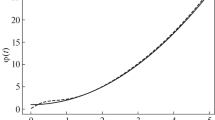Abstract
A method for enhancing the stability of parabolic inverse heat conduction problems (IHCP) is presented. The investigation extends recent work on non-iterative finite element-based IHCP algorithms which, following Beck’s two-step approach, first derives a discretized standard form equation relating the instantaneous global temperature and surface heat flux vectors, and then formulates a least squares-based linear matrix normal equation in the unknown flux. In the present study, the non-iterative IHCP algorithm is stabilized using a modified form of Beck’s sequential function specification scheme in which: (i) inverse solution time steps, Δt, are set larger than the data sample rate, Δτ, and (ii) future temperatures are obtained at intervals equal to Δτ. These modifications, contrasting with the standard approach in which the computational, experimental, and future time intervals are all set equal, are designed respectively to allow for diffusive time lag (under the typical circumstance where Δτ is smaller than, or on the order of the characteristic thermal diffusion time scale), and to improve the temporal resolution and accuracy of the inverse solution. Based on validation tests using three benchmark problems, the principle findings of the study are as follows: (i) under dynamic surface heating conditions, the modified and standard methods provide comparable levels of early-time resolution; however, the modified technique is not subject to over-damped estimation (as characteristic of the standard scheme) and provides improved error suppression rates, (ii) the present method provides superior performance relative to the standard approach when subjected to data truncation and thermal measurement error, and (iii) in the nonlinear test problem considered, both approaches provide comparable levels of performance. Following validation, the technique is applied to a quenching experiment and estimated heat flux histories are compared against available analytical and experimental results.
Similar content being viewed by others
References
Beck JV, Blakwell B, St Clair CR (1985) Inverse Heat Condution: Ill-Posed Problems. Wiley, New York
Ozisik MN, Orlande HRB (2000) Inverse Heat Transfer. Taylor-Francis, New York
Tikhonov AN, Arsenin VY (1977) Solution of Ill-Posed Problems. V.H. Winston and Sons, Washington, DC
Kurpisz K, Nowak AJ (1995) Inverse Thermal Problems. Comput Mech Publications, Boston, MA
Hensel E (1991) Inverse Theory and Applications for Engineers. Prentice Hall, New Jersey
Murio DA (1993) The Mollification Method and the Numerical Solution of Ill-Posed Problems. Wiley, New York
Alifanov OM (1994) Inverse Heat Transfer Problems. Springer-Verlag, New York
Zabaras N, Woodbury K, Raynaud M (eds) (1993) Proceedings of the Ist International Conference on Inverse Problems in Engineering: Theory and Practice. ASME, New York
Delaunay D, Jarny Y, Woodbury K (eds) (1998) Proceedings of the 2nd International Conference on Inverse Problems in Engineering: Theory and Practice. ASME, New York
Woodbury KA (ed) (2000) Proceedings of the 3rd International Conference on Inverse Problems in Engineering: Theory and Practice. ASME, New York
Orlande HRB (ed) (2002) Proceedings of the 4th International Conference on Inverse Problems in Engineering: Theory and Practice. ASME, New York
Ling XW, Keanini RG, Cherukuri HP (2003) A non-iterative finite element method for inverse heat conduction problems. Int J Numer Methods in Eng. 56:1315–1334
Keanini RG (1998) Inverse estimation of surface heat flux distributions during high speed rolling using remote thermal measurements. Int J Heat and Mass Trans 41:275–285
Beck JV (1970) Nonlinear estimation applied to nonlinear inverse heat conduction problem. Int J Heat and Mass Trans 13:703–716
Beck JV, Litkouhi B, St.Clair CR (1982) Efficient sequential solution of the nonlinear inverse heat conduction problem. Nume Heat Trans 5:275–286
Stolz G (1960) Numerical solutions to an inverse problem of heat conduction for simple shapes. ASME J of Heat Trans 82:20–26
Burgrraf OR (1964) An exact solution of the inverse problem in heat conduction theory and applications. ASME J of Heat Trans 86:373–382
Bodin J, Segerberg S (1992) Benchmark testing of computer programs for determination of hardening performance. In: George E. Totten (ed) Quenching and Distortion Control. ASM Int
Quenchalyzer Manual (2000) Instruments & Technology, Inc
Keanini RG (1997) Review: reconstruction and control of phase boundaries during fusion welding. Trends in Heat and Mass Trans 3:139–145
Author information
Authors and Affiliations
Corresponding author
Rights and permissions
About this article
Cite this article
Keanini, R., Ling, X. & Cherukuri, H. A modified sequential function specification finite element-based method for parabolic inverse heat conduction problems. Comput Mech 36, 117–128 (2005). https://doi.org/10.1007/s00466-004-0644-3
Received:
Accepted:
Published:
Issue Date:
DOI: https://doi.org/10.1007/s00466-004-0644-3




